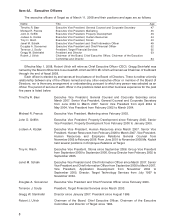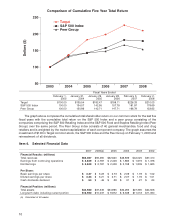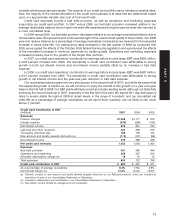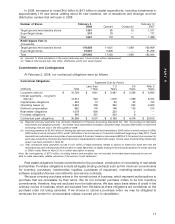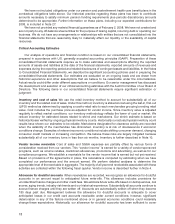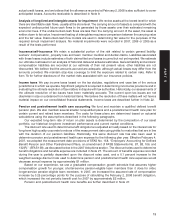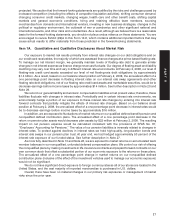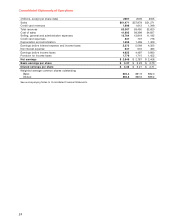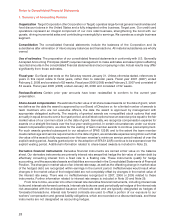Target 2007 Annual Report Download - page 36
Download and view the complete annual report
Please find page 36 of the 2007 Target annual report below. You can navigate through the pages in the report by either clicking on the pages listed below, or by using the keyword search tool below to find specific information within the annual report.We have not included obligations under our pension and postretirement health care benefit plans in the
contractual obligations table above. Our historical practice regarding these plans has been to contribute
amounts necessary to satisfy minimum pension funding requirements plus periodic discretionary amounts
determined to be appropriate. Further information on these plans, including our expected contributions for
2008, is included in Note 27.
We have not provided any material financial guarantees as of February 2, 2008. We have not created and
are not party to any off-balance sheet entities for the purpose of raising capital, incurring debt or operating our
business. We do not have any arrangements or relationships with entities that are not consolidated into the
financial statements that are reasonably likely to materially affect our liquidity or the availability of capital
resources.
Critical Accounting Estimates
Our analysis of operations and financial condition is based on our consolidated financial statements,
prepared in accordance with U.S. generally accepted accounting principles (GAAP). Preparation of these
consolidated financial statements requires us to make estimates and assumptions affecting the reported
amounts of assets and liabilities at the date of the financial statements, reported amounts of revenues and
expenses during the reporting period and related disclosures of contingent assets and liabilities. In the Notes
to Consolidated Financial Statements, we describe the significant accounting policies used in preparing the
consolidated financial statements. Our estimates are evaluated on an ongoing basis and are drawn from
historical experience and other assumptions that we believe to be reasonable under the circumstances.
Actual results could differ under different assumptions or conditions. Our senior management has discussed
the development and selection of our critical accounting estimates with the Audit Committee of our Board of
Directors. The following items in our consolidated financial statements require significant estimation or
judgment:
Inventory and cost of sales We use the retail inventory method to account for substantially all of our
inventory and the related cost of sales. Under this method, inventory is stated at cost using the last-in, first-out
(LIFO) method as determined by applying a cost-to-retail ratio to each merchandise grouping’s ending retail
value. Cost includes the purchase price as adjusted for vendor income. Since inventory value is adjusted
regularly to reflect market conditions, our inventory methodology reflects the lower of cost or market. We
reduce inventory for estimated losses related to shrink and markdowns. Our shrink estimate is based on
historical losses verified by ongoing physical inventory counts. Historically our actual physical inventory count
results have shown our estimates to be reliable. Markdowns designated for clearance activity are recorded
when the salability of the merchandise has diminished. Inventory is at risk of obsolescence if economic
conditions change. Examples of relevant economic conditions include shifting consumer demand, changing
consumer credit markets or increasing competition. We believe these risks are largely mitigated because
substantially all of our inventory turns in less than six months. Inventory is further described in Note 10.
Vendor income receivable Cost of sales and SG&A expenses are partially offset by various forms of
consideration received from our vendors. This ‘‘vendor income’’ is earned for a variety of vendor-sponsored
programs, such as volume rebates, markdown allowances, promotions and advertising, as well as for our
compliance programs. We establish a receivable for the vendor income that is earned but not yet received.
Based on provisions of the agreements in place, this receivable is computed by estimating when we have
completed our performance and the amount earned. We perform detailed analyses to determine the
appropriate level of the receivable in aggregate. The majority of all year-end receivables associated with these
activities are collected within the following fiscal quarter. Vendor income is described further in Note 4.
Allowance for doubtful accounts When receivables are recorded, we recognize an allowance for doubtful
accounts in an amount equal to anticipated future write-offs. This allowance includes provisions for
uncollectible finance charges and other credit fees. We estimate future write-offs based on delinquencies, risk
scores, aging trends, industry risk trends and our historical experience. Substantially all accounts continue to
accrue finance charges until they are written off. Accounts are automatically written off when they become
180 days past due. Management believes the allowance for doubtful accounts is adequate to cover
anticipated losses in our credit card accounts receivable under current conditions; however, significant
deterioration in any of the factors mentioned above or in general economic conditions could materially
change these expectations. Historically, our allowance for doubtful accounts has been sufficient to cover
18


